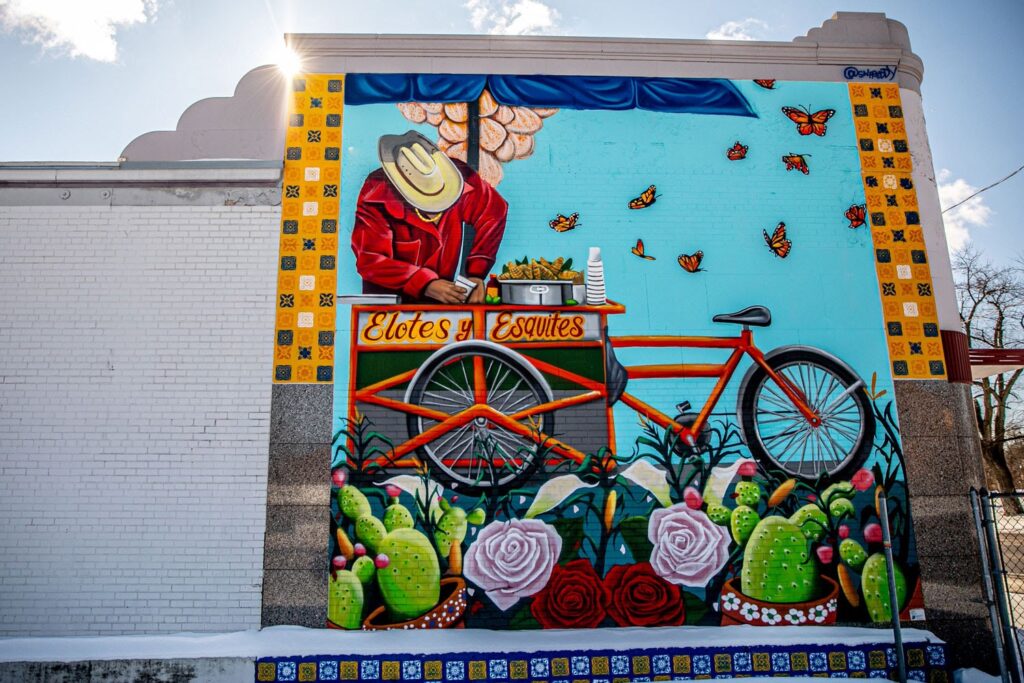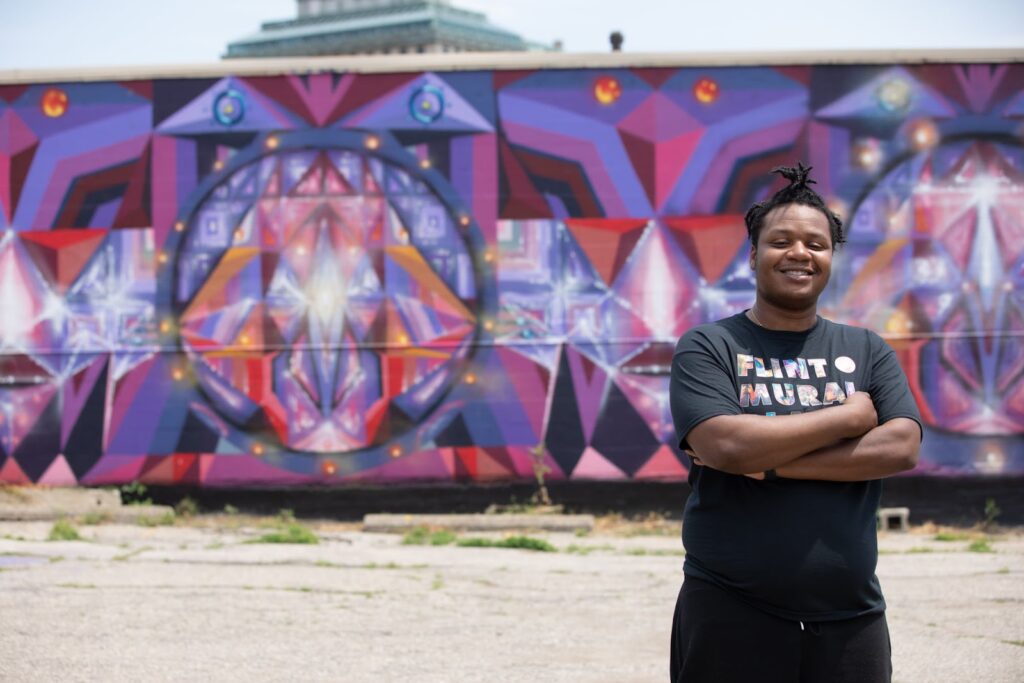Picturing the Performance: UM-Flint Students, Alumni and Faculty featured in Flint Mural Plays

Standing in front of the Flint Public Art Project mural in front of Hoffman's Deco Deli & Café, UM-Flint sophomore Olivia Maxwell-Cook watched as a group of audience members listened to her original micro audio play, "Resting Garden," using headphones. Not wearing headphones herself, all Maxwell-Cook could do was watch how the crowd was impacted. Some laughed. Some cried. Others introduced themselves to Olivia after the 8-minute production was complete, expressing how the play's mental health theme touched them personally.
"I've always been a huge fan of storytelling. I get to tell stories and try to mimic the human experience through art," Maxwell-Cook said. "I think there's something really special when you can move people like that. I'm very glad people found a connection with my play."
Maxwell-Cook's play is featured in Flint Mural Plays, a partnership between the Flint Repertory Theatre and the Flint Public Art Project. Flint Mural Plays includes 25 world premiere micro audio plays that correspond with murals located in Flint, acting as a new medium to bring theatre directly to the community. The micro audio plays will be accessible for free on the Flint Mural Plays website, a Flint Rep listening device, or the PixelStix mobile application until August 31.
Video by Flint Repertory Theatre, Voiceover by Janet Haley
Five UM-Flint students: Taylor Boes, David Guster, Olivia Maxwell-Cook, Andrea Orpinel and Enrique Vargas were given the opportunity to write plays for the production. UM-Flint faculty and alumni were involved as directors, actors, and sound designers. Janet Haley, UM-Flint Associate Professor of Theatre, was heavily involved in the project, directing 13 audio plays as well as participating as an actor.
The UM-Flint students were part of an impressive lineup that includes well-known Broadway artists. Some of the playwrights include Hunter Bell ("[title of show]"), Lauren Gunderson ("Silent Sky"), Greg Kotis ("Urinetown"), and Craig Lucas ("Prelude to a Kiss" and "Light in the Piazza").
"Our undergraduate and graduate students who were a part of this collective are in a cohort with Pulitzer Prize nominated, nationally renowned, Broadway playwrights," Janet Haley, UM-Flint Associate Professor of Theatre and Flint Mural Plays actor and director said. "I am moved, inspired, honored, and thrilled for our students and alumni to be a part of this. "
In addition to collaborating with top-tier professionals, UM-Flint artists were also able to take their productions to the next level using a recording studio at the Sylvester Broome Empowerment Village.
According to Haley, the plays are a safe and affordable way to become immersed in the arts and the Flint community, especially during the COVID-19 pandemic.
"This visual art is right on the building, so it is public art that is free and open to everyone. Everyone can go and see the mural for free and safely because it is outdoors. You can do it alone, and you don't have to buy a ticket," Haley said. "This demonstrates the interconnectedness of our community. This is a reflection of engagement, communication, innovation, and creativity."
Telling Diverse Stories

Within the 25 micro audio plays, audience members can enjoy a diverse range of genres, including musicals, dramas, and comedies. Outside of the genres, the diversity in the plays also extends into representation, languages, and themes.
"In terms of ethnic cultural identity, the plays are a lovely example of the value of diverse voices, heritage, age, and gender identity," Haley said. "The actors' voices, as well as the stories they tell, are wildly diverse and inclusive. They are celebratory to Flint and Flint's identity that is colorful, vibrant, and thriving."
For UM-Flint senior Theatre major David Guster, authenticity was key in his play, "Back to Reality," which features two local Black artists, Bree Wilson and Harvey. In the play, Guster explores the paradox of optimism and pessimism in a post-COVID world through a phone conversation. As a writer, Guster sees the importance of giving opportunities to Black artists and staying true to his culture.
"'Back to Reality' is a fun phone call that features African American vernacular," Guster said. "This means that it represents our community in an accurate way."
The diverse voices in the plays are also made accessible to the cultures they portray. "Elotes y Esquites," co-written by UM-Flint senior Theatre major Enrique Vargas and UM-Flint alumna Andrea Orpinel, is available as both a Spanish and English recording.
"This was our chance to create something for the people around here to be really involved with and to interact with," Vargas said. "Theatre is an art form that is meant to be enjoyed and shared as a collective experience by all people from different walks of life. It was really important to us that we made the play accessible to all of the potential audiences."
Other plays include a range of underlying themes and messages, including "Resting Garden" by sophomore Olivia Maxwell-Cook, which is a symbolic representation of mental health.
"A lot of people have trauma from the pandemic, and that needs to be addressed," Maxwell-Cook said. "I want to remind people to take care of their mental health, which is so important."
UM-Flint Connections

For UM-Flint student playwrights, Flint Mural Plays was the ideal opportunity to apply knowledge obtained from the Theatre program at UM-Flint.
According to Guster, the performing experience as an actor helped to visualize the play in its beginning stages.
"Being a Theatre Performance major at UM-Flint helped me get more of a vision of what I wanted the piece to sound like. I was also able to act it out as I was writing it," Guster said.
UM-Flint experience played a role for Vargas to better understand other aspects of theatre, such as professionalism and storytelling.
"UM-Flint helped instill the sense of professionalism in me, and put that professional foot forward. I was also able to understand the fundamental roots of theatre and storytelling," Vargas said. "I think my time at UM-Flint has been leading me up to this moment."
Flint Arts Persevere

Those outside of the city can also take part in the Flint Mural Plays, as accompanying pictures of the murals are available on the website.
"If people live out of state and they can't get to the murals, they can still see that these plays are celebrating the beauty, progress, and transformation of Flint, which is a core part of our campus," Haley said.
In a time where the COVID-19 pandemic limited many opportunities for artists, the Flint Mural Plays emerged as a safe alternative to continue the arts in the community.
"This is bridging the gap between the typical theatre setting and a new wave of creating art in the post-COVID world. As a whole, it's something that Flint should be really proud of," Vargas said. "If you're a fan of theatre, you're getting to listen to these awesome plays and listen to the awesome work the voice actors are doing. If you're a native of this area, you have the opportunity to walk around your own city and be a tourist in your hometown to see all of these beautiful pieces of art."
For more information and to listen to the Flint Mural Plays until August 31, visit flintmuralplays.org.
Related Posts
No related photos.
UM-Flint News
The Office of Marketing & Communications can be reached at [email protected].